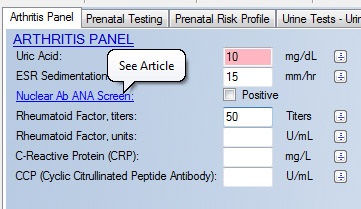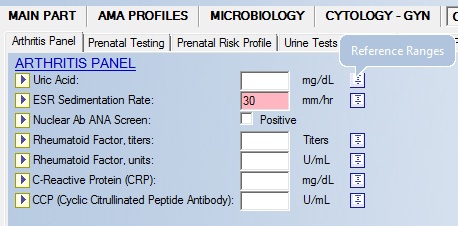| Test Window - Complex Edit Form
|
|
|
| The upper section of Test window allows you insert patient's personal demographic data.
|

|
| You are able to insert the following patient's parameters:
|
| Patient's Last Name;
|
| Patient's First Name;
|
| Patient's MI - middle initial;
|
| Patient's Address;
|
| Patient's City;
|
| Patient's State;
|
| Patient's ZIP code;
|
| Patient's PatientID (or medical record number);
|
| Patient's Phone;
|
| Patient's DOB – date of birth;
|
| Patient's Sex;
|
| You can specify if the patient is Smoker or not.
|
| The DOB, Sex, and Smoker are required parameters for Test Analysis process.
|
|
|
| The Medical Tests Analyzer Test window is split into several tab pages.
|

|
| Each tab page represents a lab test panel or a tests profile. The tab pages are separated into five categories:
|
| MAIN PART
|
| AMA PROFILES
|
| MICROBIOLOGY
|
| CYTOLOGY – GYN
|
| OTHER PROFILES
|
| For example, if you have recently passed a cholesterol examination you can insert your lab results into AMA PROFILES category on Lipid Panel tab page.
|
| Also if you have a difficulty to find some specific test procedure click 'Search Procedure' button and select the procedure from drop-down list of all procedures.
|
|
|
| You can read an article about each test procedure.
|

|
| Just move mouse over the procedure title and click on it. A pop-up article window will appear where you will find an explanation about the lab test purpose, test results and other related materials.
|
|
|
| The units of measurement that labs use to report your results can vary from lab to lab. It is similar to the way, for instance, your physician chooses to record your weight during an examination. He can decide to note your weight in pounds or in kilograms. In this same way, labs may choose to use different units of measurement for your test results. Regardless of the units that the lab uses, your results will be interpreted in relation to the reference ranges supplied by the laboratory.
|

|
| You can adjust measurement units naming and reference ranges as well. Select a parameter on your test you want to update, for example 'Rheumatoid factor'. On the right hand of the parameter you can find a small button |
|
|
| Beside each of procedure test name on its left side you can see a small button |

|
| Some Test Procedure can take Positive or Negative values by default only. However you probably will need Reference Ranges for numeric values of some procedure. So you able to change the Test type for such procedures.
|
| Also by clicking the same button |
|
|
| If you cannot find some test Procedure you may create some new procedure and insert it into Medical test analyzer interface. By using the following button:
|

|
| that is located on the right-upper corner of the Complex Edit Form, you can call and use the special Create New Test Procedure interface to describe and include some procedure that is not presented in MTA.
|
|
|
| When you finished results update click the "Analyze" button. It will generate lab results analysis report that will include interpretations of critical results that are abnormal or outside the reference range. It will note on the report what certain test results may indicate.
|
|
|
|
|
|
|
|
|
Copyright © 2021